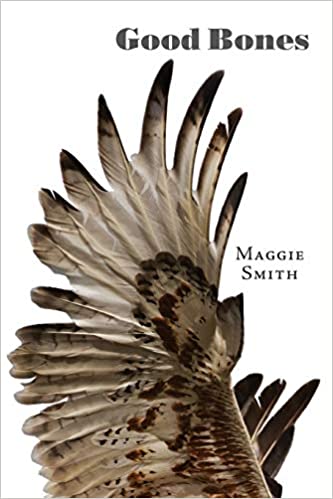Books |
Maggie Smith: Good Bones
By
Published: Jul 26, 2020
Category:
Poetry
In 2015 Maggie Smith sat in a Starbucks in Bexley, Ohio, and wrote a poem on a legal pad.
She didn’t think “Good Bones” was her best poem, but she sent it out. Rejections followed.
The online literary journal Waxwing published “Good Bones” in June 2016, That was the week a gunman killed 49 people at the Pulse nightclub in Orlando. A reader published it on Facebook, a musician shared it on Twitter, celebrities endorsed it. The assassination of British politician Jo Cox produced more readers, and after the election of Donald Trump, it was, with Maya Angelou’s “Still I Rise” and W.H. Auden’s “September 1, 1939,” the mostly widely read poem on the planet — it would be called “the poem of 2016.”
It’s this:
Life is short, though I keep this from my children.
Life is short, and I’ve shortened mine
in a thousand delicious, ill-advised ways,
a thousand deliciously ill-advised ways
I’ll keep from my children. The world is at least
fifty percent terrible, and that’s a conservative
estimate, though I keep this from my children.
For every bird there is a stone thrown at a bird.
For every loved child, a child broken, bagged,
sunk in a lake. Life is short and the world
is at least half terrible, and for every kind
stranger, there is one who would break you,
though I keep this from my children. I am trying
to sell them the world. Any decent realtor,
walking you through a real shithole, chirps on
about good bones: This place could be beautiful,
right? You could make this place beautiful.
Note: Ohio State University, mired in the 19th century, sliced the word “shithole” out of the video.
With each new tragedy, “Good Bones” finds new readers. “I can tell something bad is happening in the world when my poem is surging,” Smith says.
What’s its appeal? Set aside the bluntness and simplicity of this style of writing. Consider the universality of its message to parents, and especially to mothers: how to talk to children about life’s most painful realities. “I was troubled by the question of how we teach our kids about the world without lying to them — telling them that it’s all good — and telling them the truth without scaring them. The poem was written from the point of one mother feeling anxious about how to raise kids and explain a world to them that is as wonderful as it is terrible, about how to keep the worst parts from then while they’re young, while not lying to them.”
As is “Heart,” another poem from the book:
A child of, say, six knows you’re not the shape
she’s learned to make by drawing half along a fold,
cutting, then opening. Where do you open?
Where do you carry your dead? There’s no locket
for that—hinged, hanging on a chain that greens
your throat. And the dead inside you, don’t you
hear them breathing? You must have a hole
they can press their gray lips to. If you open—
when you open—will we find them folded inside?
In what shape? I mean what cut shape is made
whole by opening? I mean besides the heart.
Another, “First Fall,” with a child at its center:
I’m your guide here. In the evening-dark
morning streets, I point and name.
Look, the sycamores, their mottled,
paint-by-number bark. Look, the leaves
rusting and crisping at the edges.
I walk through Schiller Park with you
on my chest. Stars smolder well
into daylight. Look, the pond, the ducks,
the dogs paddling after their prized sticks.
Fall is when the only things you know
because I’ve named them
begin to end. Soon I’ll have another
season to offer you: frost soft
on the window and a porthole
sighed there, ice sleeving the bare
gray branches. The first time you see
something die, you won’t know it might
come back. I’m desperate for you
to love the world because I brought you here.
Her near obsession with what parents can responsibly tell their children without souring them on the world is — no surprise — rooted in her biography. As a child, she was fearful about everything; she had a condition that might be called Pre Traumatic Stress Disorder. Now she’s divorced after a 19-year marriage — she wrote about the end of the marriage in a Times “Modern Love” column. She has two young children. She still lives in Bexley, a suburb of Columbus, Ohio. Poetry is not the most lucrative profession; she consults with writers and edits manuscripts. It’s not surprising that women identify with her; considering how many men are also at home now, she’s poised to have a wider, broader audience. [To buy the book from Amazon, click here. For the Kindle edition, click here.]
Of course you wonder: What do her children know? Has she shared “Good Bones” with them? Thank you, Nora Krug, of the Washington Post, for asking these questions:
Smith has been wary of discussing the poem with her own children. For her, the trouble is not so much the expletive but the idea “that half the world is terrible.” That’s a pretty bleak outlook for children under 10 to contend with, she admits. At the same time, she says, “I don’t want my kids to turn 15 and all of the sudden that idea drops in their laps. We have a responsibility to tell them the truth.”


